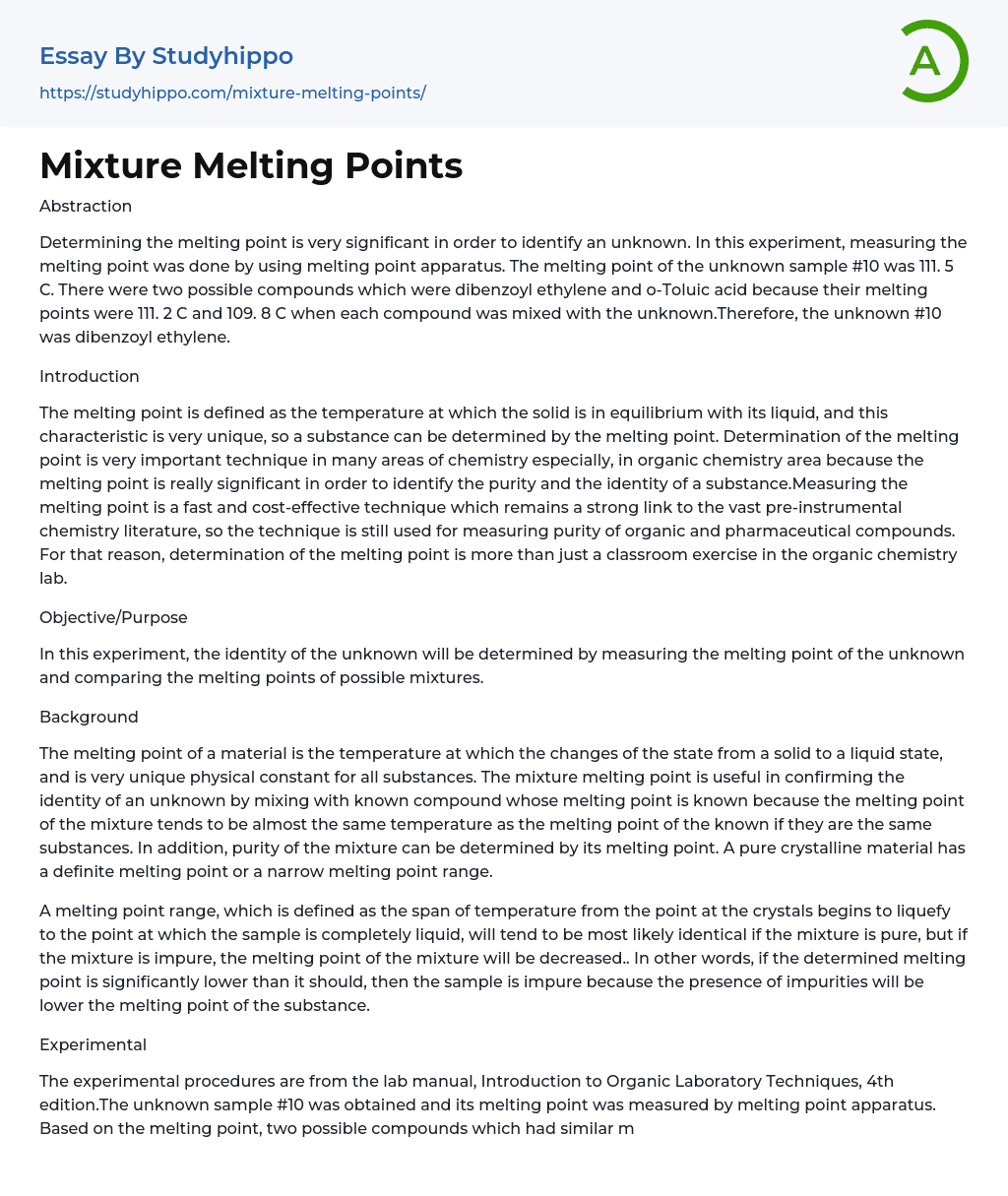Abstraction
The determination of the melting point is crucial for identifying an unknown substance. For this experiment, a melting point apparatus was used to measure the melting point. The melting point of the unknown sample #10 was found to be 111.
5 C. The melting points of two compounds, dibenzoyl ethylene and o-Toluic acid, were considered to determine the identity of an unknown substance (#10). When mixed with the unknown, dibenzoyl ethylene had a melting point of 111.2 C and o-Toluic acid had a melting point of 109.8 C. Based on these results, it can be concluded that the unknown substance is dibenzoyl ethylene.
Introduction
The melting point is an important characteristic for identifying substances as it represents the temperature at which a solid reaches equilibrium with its liquid form. Therefore, it is a valuable tool for substance identification.
The determination of the melting point is a
...crucial technique in various areas of chemistry, especially in organic chemistry, for assessing purity and identity of substances. This cost-effective and efficient method has strong ties to historical chemistry literature and continues to be used beyond just a laboratory exercise, particularly in measuring the purity of organic and pharmaceutical compounds.
Objective/Purpose
This experiment aims to identify an unknown substance by comparing its melting point with possible mixtures' melting points.
Background
The melting point signifies the temperature at which a material transitions from solid to liquid state, serving as a unique physical constant for all substances. By combining an unknown substance with another compound having a known melting point, the mixture's melting point can help verify the identity of the unknown substance if they are similar.
An indication of a mixture's purity can be determined b
analyzing its melting point. A pure crystalline substance will have a specific range for melting, from the temperature at which crystals begin to liquefy until complete liquid state is achieved. If the mixture is pure, this range will remain consistent. However, the presence of impurities in the mixture causes its melting point to be lower than expected. In other words, a significantly lower measured melting point suggests that the sample is impure due to impurities reducing its melting point.
Experimental
The experimental procedures were obtained from "Introduction to Organic Laboratory Techniques, 4th edition" lab manual. The unknown sample #10 was acquired and its melting point was measured using a melting point apparatus.
Two compounds were selected based on their melting point, which were similar to the unknown compound. Two mixtures were created by combining equal amounts of one potential compound and the unknown #10 using a watch glass. The melting points of all the mixtures were measured using a melting point apparatus. By comparing the melting points of the mixtures, the identity of the unknown compound was determined.
Results and Discussion
The melting point determination showed that unknown #10 had a melting point of 111.5°C. This indicated that dibenzoyl ethylene and o-Toluic acid could potentially be compounds in question, as their melting points closely matched that of the unknown.
After discovering that the melting points of each compound were too similar to the unknown, they decided to combine them for further evaluation. The resulting mixture consisted of dibenzoyl ethylene and the unknown, which exhibited a melting point of 111.2°C. In comparison, the mixture containing o-Toluic acid and the unknown displayed a slightly lower melting point of 109.8°C. By comparing these values
with the melting point of the unknown substance, it was determined that the mixture with dibenzoyl ethylene closely corresponded. This strongly implies that dibenzoyl ethylene is likely to be the unidentified compound due to their close alignment in terms of melting points.
Both the unknown substance and o-Toluic acid, being different substances, caused a decrease in the melting point of the mixture. This decrease was attributed to impurities present in the mixture, illustrating how measuring melting points can determine both purity and identity of a compound.
A potential error during the experiment could have been adding unequal amounts of the unknown and known compounds while combining them. This mistake resulted in inaccurate results, necessitating a repetition of the experiment.
To summarize, this laboratory aimed to identify an unknown sample by using the melting point technique to combine it with possible compounds. Determining melting point is crucial for identifying an unknown substance.
The melting point of an unidentified sample labeled as #10 was determined using a melting point apparatus. The recorded melting point for this sample was 111.5°C. When the unknown sample was mixed with another substance, two possible melting points were observed: 111.2°C and 109.8°C.
Unknown sample #10 can be identified as dibenzoyl ethylene because its melting point is similar to that of the mixture of dibenzoyl ethylene.
- John Locke essays
- 9/11 essays
- A Good Teacher essays
- A Healthy Diet essays
- A Modest Proposal essays
- A&P essays
- Academic Achievement essays
- Achievement essays
- Achieving goals essays
- Admission essays
- Advantages And Disadvantages Of Internet essays
- Alcoholic drinks essays
- Ammonia essays
- Analytical essays
- Ancient Olympic Games essays
- APA essays
- Arabian Peninsula essays
- Argument essays
- Argumentative essays
- Art essays
- Atlantic Ocean essays
- Auto-ethnography essays
- Autobiography essays
- Ballad essays
- Batman essays
- Binge Eating essays
- Black Power Movement essays
- Blogger essays
- Body Mass Index essays
- Book I Want a Wife essays
- Boycott essays
- Breastfeeding essays
- Bulimia Nervosa essays
- Business essays
- Business Process essays
- Canterbury essays
- Carbonate essays
- Catalina de Erauso essays
- Cause and Effect essays
- Cesar Chavez essays
- Character Analysis essays
- Chemical Compound essays
- Chemical Element essays
- Chemical Substance essays
- Cherokee essays
- Cherry essays
- Childhood Obesity essays
- Chlorine essays
- Classification essays
- Cognitive Science essays




